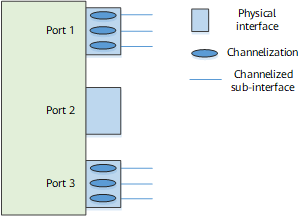Application Scenarios for VLAN Channelized Sub-Interfaces
The 5G network carries three types of services: Enhanced Mobile Broadband (eMBB), Massive Machine-type Communications (mMTC), and Ultra reliable and low latency communications (URLLC). Services of different types need to be carried through different network slices.
To prevent services from affecting each other, a mechanism to isolate different types of services is needed. Physical bandwidth isolation is the simplest way to differentiate services. With the continuous evolution of high-performance ports on routers, no service traffic of any type exclusively consumes bandwidth of a high-performance port in a short period. Therefore, the channelization technology can be used for high-performance ports to isolate different types of services.
Different service flows are forwarded through specific VLAN channelized sub-interfaces with dot1q encapsulation. Each channelized sub-interface implements independent HQoS scheduling to isolate services of different types. As shown in Figure 1, Port 1 and Port 3 indicate channelized interfaces, and Port 2 is a physical interface.
- Isolate outgoing traffic on a backbone and aggregation network.
- Isolate outgoing traffic on the PE network side.
